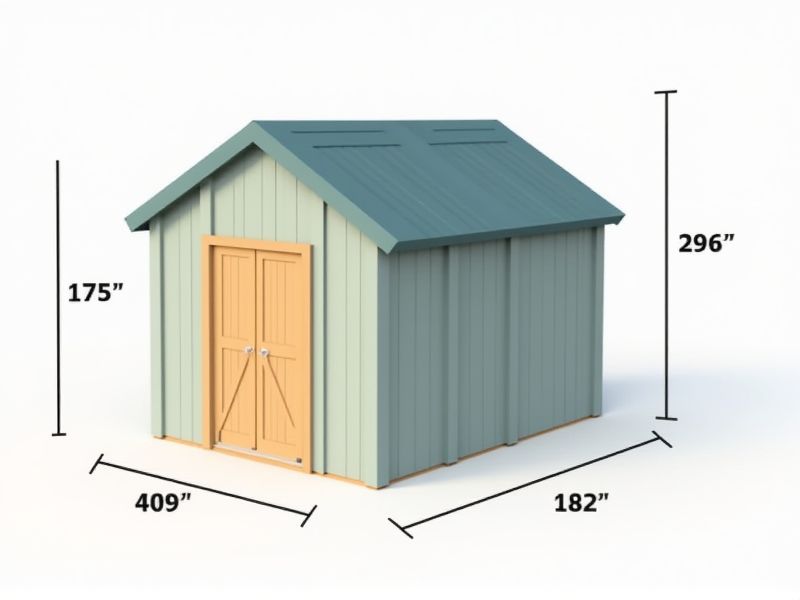
When planning for a storage shed, it's helpful to know the standard dimensions most commonly available. Typical storage sheds come in sizes like 6x8 feet, 8x10 feet, and 10x12 feet, with heights generally ranging from 7 to 9 feet. Choosing the right size depends on how much you need to store--small tools and lawn equipment may fit in a 6x8, while bicycles or larger equipment might require an 8x10 or 10x12 shed. Knowing these standard options makes it easier to select a shed that fits your available space and storage needs.
Width
The standard width for storage sheds typically ranges from 6 to 12 feet, catering to various homeowner needs. A width of 8 feet is often recommended for accommodating standard lawn equipment and tools, while larger widths can provide additional space for household items. Your choice of width can significantly impact the shed's functionality and accessibility, ensuring easy maneuverability for storage and retrieval. Investing in a well-sized shed can improve organization and maximize your outdoor space effectively.
Length
A standard storage shed typically measures around 8 to 12 feet in length, providing ample space for garden tools, bicycles, or outdoor equipment. Consider a longer length, such as 10 to 16 feet, if you require additional room for larger items or more organized storage solutions. Ensure that the shed's length accommodates your specific needs without overwhelming your outdoor space. Properly installed, a well-sized shed can enhance the functionality of your yard while maintaining an aesthetically pleasing appearance.
Height
Height is a critical factor in the standardization of storage sheds, typically ranging from 6 to 12 feet depending on the intended use. A standard shed height of 8 feet often accommodates most storage needs, allowing for easy access and adequate vertical space. For users storing larger items, such as gardening equipment or bicycles, sheds with heights exceeding 10 feet provide added convenience and flexibility. Your ideal shed height should consider not only storage capacity but also local zoning regulations, which may impose specific height restrictions.
Door Size
The standard door size for storage sheds typically measures 36 inches wide by 80 inches tall, which ensures easy access for most equipment and tools. Some models may offer double doors with a combined width of 60 to 72 inches, ideal for larger items like lawnmowers or bicycles. Proper door dimensions enhance functionality, allowing for efficient transportation of goods in and out of the shed. When selecting a storage shed, consider these dimensions to ensure that it meets your specific storage needs effectively.
Roof Pitch
The roof pitch of a storage shed significantly impacts its durability and functionality, typically varying from 2:12 to 12:12. A steeper pitch, such as 8:12, promotes better water drainage, reducing the risk of leak and snow accumulation, while a lower pitch offers a more accessible space for storage. You should consider materials corresponding to the pitch, with metal roofing being ideal for steep angles and asphalt shingles better suited for gentle slopes. Proper roof pitch not only enhances aesthetics but also ensures compliance with local building codes, which may stipulate minimum pitches for specific climates.
Floor Space
The optimal floor space for a storage shed typically ranges from 100 to 200 square feet, providing ample room for tools, garden supplies, and outdoor equipment. A well-organized shed layout can maximize efficiency, allowing for vertical storage solutions such as shelves and hooks, which utilize the full height of the structure. Climate considerations also play a crucial role, as insulated sheds can protect sensitive items from extreme temperatures and humidity. When selecting a location for your storage shed, ensure it is easily accessible while maintaining adequate space for ventilation and natural light.
Wall Thickness
The standard wall thickness for storage sheds ranges from 1.5 inches to 2.5 inches, which significantly impacts durability and insulation. High-quality materials such as treated wood or galvanized steel are commonly utilized to enhance the structural integrity and weather resistance. A thicker wall provides better protection against the elements, reducing the risk of rot and mold, while also offering improved energy efficiency. When selecting a storage shed, consider how wall thickness contributes to overall longevity and functionality.
Window Placement
Optimal window placement in storage sheds enhances natural light and ventilation, significantly improving accessibility and usability. You can expect around 10-15% more interior light with strategically positioned windows, which also helps prevent moisture buildup. Standard practices recommend placing windows on the south-facing wall to maximize sunlight exposure throughout the day. Ensuring proper window size--with dimensions like 24x36 inches--facilitates airflow while still securing the integrity of the shed.
Ventilation Space
Proper ventilation is crucial for the longevity and functionality of your storage shed, as it helps regulate temperature and humidity levels. Typically, a well-ventilated shed should have at least one vent for every 100 square feet of floor space, allowing for adequate air circulation. This setup minimizes moisture buildup, which can lead to mold and wood rot, ensuring your stored items remain in optimal condition. Consider incorporating ridge vents or gable vents to enhance airflow effectively, especially in sheds that are tightly sealed.
Foundation Requirements
When constructing a storage shed, a robust foundation is crucial for longevity and stability, typically requiring a solid base of crushed stone or concrete. Common standards recommend a minimum thickness of 3-4 inches for concrete pads to ensure weight distribution and moisture resistance. For raised structures, a pressure-treated wood frame may be used to protect against rot, requiring adequate ventilation for air circulation. Adhering to local building codes, which may mandate specific foundation depths and materials, ensures compliance and enhances structural integrity.
